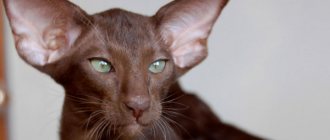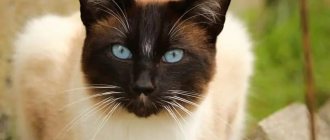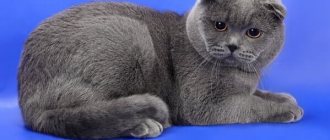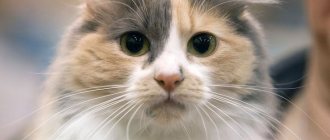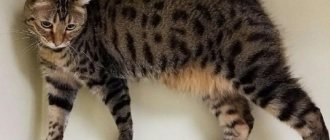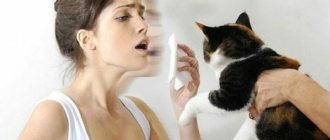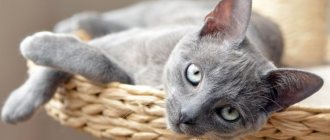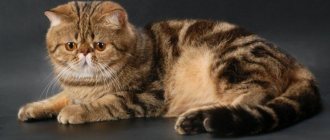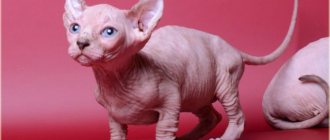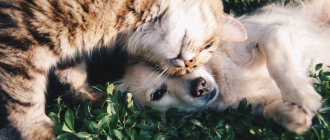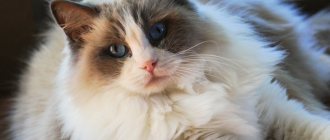Why does a cat have big ears?
A very common misconception is that the larger the ears a cat has, the better it can hear. Nothing of the kind: the size of the auricle in no way affects the acuity of a cat's hearing. Cats with small ears have just as good hearing as cats with large ears.
Big ears on a cat are beautiful
This anatomical feature has a purely utilitarian explanation - it is a unique and quite effective cooling system. Initially, it is inherent in those cat breeds that are of eastern or southern origin - the regulation of heat exchange is especially important for them.
A huge number of capillaries are concentrated in the auricle. Passing through these vessels, the blood is cooled to the optimal temperature, which helps the cat avoid unnecessary overheating. In hot weather, blood circulation occurs faster, in cool weather - slower. That's the whole secret.
Large ears help a cat regulate its temperature balance
Eared cats look funny and unusual. Breeders cultivate this feature solely for the sake of breed marketing - exotic appearance stimulates sales. Therefore, it is difficult to say that super ears are so necessary for modern cats to live a normal life. On the other hand, this doesn’t really bother them.
Cat breeds with big eyes
Big-eyed cats are different.
The gaze of some can be called purposeful and cunning, while others can only express adoration for a person or a plea for a tidbit with their eyes. Dilated pupils, like saucer eyes, add special significance to a cat’s gaze. Peering into their depths, people rarely realize what kind of eyes their pet has: round, almond-shaped or slanted. The first two types can be confidently called large.
The owners of large eyes can be different cats: long-haired or short-haired, small or medium-sized, with or without a tail. The most popular breeds of big-eyed cats:
- Persian;
- British;
- Scottish lop-eared;
- Abyssinian;
- Japanese Bobtail;
- Singapore;
- Ukrainian Levkoy;
- ragdoll
Persian cat
This is the name of the breed with long fluffy hair and a flattened muzzle with a snub nose. Persian cats are incredibly popular. Breeders love the gentle, calm nature and cozy appearance of animals. Persian cat eyes:
- Perfect round shape;
- Clearly stand out against the background of the muzzle;
- They have different shades, depending on the color of the coat.
Persian cats require daily care. The coat should be combed and washed with a special shampoo. The animal needs regular intake of vitamins to maintain the condition of its hair.
The cost of a big-eyed Persian cat varies from 2 to 16 thousand rubles, depending on the pedigree.
This is interesting! Cats' true eye color may not appear until they are one year old. Up to six months, cats have a dull blue tint to their eyes.
British
It seems that the large, wide-set eyes of these cats are wide open to the whole world. And at the same time they look quite intently, which makes their gaze even more open. Often, British eyes have an intense copper tint, less often blue or green.
As for character, these cats are mostly calm and balanced. In addition, they are smart, strong and kind. And for their independence and purely English manners, these animals received the nickname - cats for businessmen. The British undoubtedly love their breadwinners, but at the same time they tolerate their long absence quite calmly and, being alone, always find something to do.
Scottish lop-eared
The Scottish Fold (Scottish Fold) is an animal with a stocky build and floppy ears that completely cover the pinna. Folds seem heavy due to their round head and short legs, and their tail is of medium size. However, the Scots cannot be called heavyweights. A cat can only grow up to 6–7 kg, and a cat can only grow up to 4–4.5 kg. With their large eyes, small nose and wide-set floppy ears, these cats look naive (like toys), but that's what people like about them. The fold can be any color (there are more than 60 types).
The Scots are calmness itself. Such a cat can be confidently called the most balanced. He is not lazy, but extremely peaceful, so he gets along well with all family members. The big-eyed, fold-eared cat will make friends with any other pets, because he is smart and understands that they are also part of the family. But this cat does not really like strangers. He, of course, will not rush at the guests, but he will not caress them either.
The most unusual dwarf breeds
We present to you a list of the most unusual breeds of dwarf cats with photos:
Bambino
This extraordinary breed was created by crossing the Munchkin and Sphynx breeds. The result probably exceeded all the expectations of geneticists! The result was a cat with the “bald” gene of the sphinx and the short legs of the munchkin. We didn’t think about the name for a long time - the Italian word “bambino” (“child”) suited it perfectly. Despite these genetic mixes, the Bambino is a very healthy breed. These dwarf cats have excellent immunity, as well as excellent developed muscles and a strong skeleton. In addition, they are characterized as pets with high intelligence and the ability to learn commands.
Munchkin
Quite cute cats that look like kittens. It is noteworthy that munchkins are surprisingly similar to small kittens, even being cats of advanced age. This breed is known for its childlike expression and short but thick legs. Munchkins are unusually playful and cheerful. Chances are you'll never see a bored munchkin. Cats of this breed easily find something to do and, in addition, get along well with children and other cats.
https://youtube.com/watch?v=4e-8Y6GtS4E
Skif-tay-don
Another fidget breed. Representatives of this breed have a striking distinctive feature - a shortened tail (usually 2-3 vertebrae long). Scythian Tai Dons are ebullient figures. They can follow their owner anywhere due to their attachment to the person. At any opportunity, this lump climbs into the lap of any member of the household, and can lie there for hours, purring sweetly.
Curl
These beauties were bred by American felinologists. A distinctive feature of the American Curl is its curved ears, which is why the breed actually got its name (from the English Curl - curly). For a long time the breed was not recognized, but in 1995 the first curls appeared at exhibitions and immediately won the love of many people. The population of these cats is low. In addition, American breeders are very concerned about the purity of the breed. These kittens are very rarely sold outside the United States, so getting a Curl in the CIS countries is a real miracle!
https://youtube.com/watch?v=LXiConOEiKw
Features of caring for cats with a flattened face
Cats with a flattened muzzle are not found in nature (with the exception of the Pallas cat, which to some extent became the progenitor of most modern breeds of brachycephalic cats).
Due to mutations at the gene level, carriers of cute flattened faces often experience breathing problems. Because of this, both a small kitten and an adult cat with a brachycephalic skull structure often snore in their sleep and slurp while eating (the animal is simply uncomfortable breathing). However, the manifestation of the first painful symptoms usually begins at an advanced age for the cat.
In addition, breeders of such breeds note that cats with flattened faces suffer more often and more severely from colds and allergies; with the slightest cold, the cat will experience problems with nasal discharge. Therefore, we need to take better care of their health.
The specific structure of the muzzle also dictates its own nutritional rules for brachycephals: for example, purebred cats with a flattened muzzle are usually extremely capricious in their menu. They prefer premium food or natural poultry and fish. In summer, you can give animals fresh vegetation. It is not recommended to feed such cats regular homemade food - it contains many spices that are harmful and even dangerous for your pet. In addition, due to mutations, brachycephals have very sensitive digestion.
Excessive lacrimation is another “scourge” of poor animals. Due to the short shape of the muzzle, the eyes of cats are set closer than dictated by the needs of nature - because of this, the functioning of the lacrimal glands is disrupted. When a cat has a cold, their eyes can often become inflamed and fester.
The specific structure of the skull imposes many responsibilities on the owners of such cats. All breeds of cats with a flattened face require careful care in various respects.
Cats with a flattened face should be protected from drafts and temperature changes.
Thus, the general rules for caring for brachycephalic cats are as follows:
- Feeding with premium food (both wet and dry).
- Daily eye cleaning (with a cotton pad soaked in tea leaves or chamomile decoction).
- Regular cleaning of the ears (with a cotton swab).
- Trimming nails if the animal has a habit of tearing up upholstered furniture.
- Regular examination by a veterinarian (with age, cats with flattened faces find it harder to breathe).
- Keeping exclusively at home without drafts and trips to nature.
With a large selection of cat breeds with a flattened face, you need to understand that any breed is the result of a random gene mutation or the work of breeders. Beautiful and affectionate cats with brachycephaly need special care and attention. Therefore, when choosing a pet, you should take this fact into account.
If the owner is not ready to pay attention to his pet, then it is better to choose an ordinary cat
Flat-faced cats were artificially bred and separated into separate breeds, of which there are not many in the world.
Persians are the most popular among them, although other representatives cannot be ignored, from exotic and Himalayan cats bred from Persians with their long hair to proud British or fold-eared Scottish Folds. And each of them has a characteristic feature - the brachycephalic shape of the muzzle, giving the pet a doll-like expression. But it is worth noting that such animals require special care.
But it is worth noting that such animals require special care.
Features, pros and cons
There are a great many different breeds of cats, and each of them has its own individual characteristics that distinguish them from other subspecies. This non-standard structure of the animal skull is otherwise called brachycephalic. This is not the design of nature, but the work of man - cats and cats with similar features were bred artificially. In fact, this design of the animal’s muzzle is not normal.
Simply put, it is a kind of pathology. But today animals with such a structure are not treated as defective. On the contrary, charming owners of flattened faces are incredibly popular and loved by many people. Representatives of several well-known breeds have a flattened muzzle.
It is worth understanding what the main pros and cons of cats with flat faces are. Let's start with the good - let's look at the positive aspects.
- The main advantage that is noticed about such pets is their original and very interesting appearance. Even in our time, when it is difficult to surprise anyone with cats of various breeds, animals with a brachycephalic skull attract a lot of attention.
- The jaws of such pets are stronger than those of representatives of breeds with a classic muzzle structure.
- The lion's share of cats with a similar structure have a very affectionate, friendly character. They are sociable, unobtrusive and behave absolutely calmly in everyday life. These are the qualities that many people look for in pets.
Now let’s look at what are the shortcomings of these unusual pets.
- For such cats, it is necessary to select not ordinary, but special dishes from which they can drink and eat comfortably, without unnecessary interference.
- The non-standard shape of the skull of these pets becomes an inevitable cause of noisy sleep, snoring and snorting. Some people really don’t like these features of animal behavior and cause irritation.
- Cats with a flattened face are distinguished by having shortened tear ducts and a non-specific nose shape. These factors lead to the fact that such pets, experiencing severe stress, may suffer from severe discharge. Similar problems can arise if the cat has been in the cold.
- Some species of animals with a similar skull structure cannot eat on their own, regardless of the selected food and its consistency. Such animals should be treated like small children - spoon-fed. Not every person agrees to this, so you need to think several times whether you are ready to acquire such a fluffy fidget.
- The peculiarities of thermoregulation in these animals are such that they cannot tolerate the influence of low temperatures.
- Due to the nasal discharge described above, such cats very often suffer from various types of infectious diseases. In addition, they are prone to allergic reactions.
From all of the above, we can conclude that such cats have more disadvantages than advantages. Although, many of the disadvantages of such animals are better called their features.
Breed of cats with tassels on ears - breed, photo, description
Cat breeds with tufted ears are quite popular today. Many people want to find a specific variety and are willing to pay a lot of money for it. Such cats are beautiful, elegant, sociable and quickly become members of the family.
Maine Coon
These are semi-longhaired cats bred in America and are one of the largest purebred cats in the world, created to live with humans. These are large animals with an amazing appearance, various color options and a gentle disposition.
Maine Coons originally originated in the northeastern United States about a century ago. The second part of the name means raccoon, and this is explained by the fact that the coat of cats is similar to that of a raccoon. The tassels on the ears remind people of lynxes.
The development of the breed took place in northern cold conditions, which is why such pets have wide bones and long hair between the toes. Males can weigh more than ten kilograms.
By nature, Maine Coons are true homebodies who do not require increased attention to themselves. They don't like to be alone, so if you go somewhere or are away, make sure your pet has a sufficient number of toys.
Maine Coons communicate using a variety of sounds. They not only meow, but also make sounds similar to birdsong.
The breed is suitable for any climate; harsh winters and snowy weather are not a problem for them.
Norwegian forest
Official registration took place in 1970. These are unusual and powerful animals, different from their relatives.
Specific features of Norwegian forest cats:
- dense water-repellent wool;
- large flexible bones, elongated torso and strong muscles;
- large triangular head;
- large ears with tassels;
- oval-shaped paws with hair between the toes, long limbs;
- large round eyes with a color matching the coat;
- straight and very fluffy tail;
- mustaches that stick out in different directions.
Read also: Bobtail - types and their descriptions 33 photos
Norwegian Forest Character Traits:
- patient and calm;
- can play with small children;
- get along well at home;
- they are easy to train;
- love to sleep;
- playful, have a hunting instinct;
- love freedom and walks in the fresh air;
- Small rodents or birds should not be kept in the same room as Norwegian forest animals.
Pixie bob
A rare cat breed similar to a lynx. This pet is ideal for living with people; it can be trained and taken for walks on a leash.
These are talkative cats and meow often. They have a gentle and kind disposition, and the only requirement is constant contact with the owner.
The pixie bob has a large body, a short tail and a small ponytail. Its fur can be both long and short.
Chauzie
The Shawsie was bred by crossing a common cat and a jungle cat.
These animals are energetic and love to play. They do not like loneliness, so they try to take part in all the affairs of each of the household members. They quickly establish strong friendships with children.
Caracal
An elegant and beautiful animal, an inhabitant of Asian and African countries. This breed of big cats not only has tufts on its ears, but also sharp eyesight and sensitive hearing, as well as strong limbs and a large body.
Today, the cost of a caracal is ten thousand dollars; it is a rare pet, which is a sign of the wealth of its owners. It should not be brought into homes with small children.
It is better to buy such a kitten at the age of six months; during this period, he quickly gets used to others.
Caracal does not tolerate rude treatment and punishment.
Caracals do not like the cold, but they love water treatments.
A well-bred caracal will turn into both a good and faithful comrade and a reliable guard.
Siberian cat
It was officially registered in 1980. Semi-long-haired breed with pronounced or completely invisible tufts on the ears. The body is massive and the legs are strong. The Siberian cat weighs about six kilograms.
These are quite versatile pets. They love affection and are quite friendly.
Read also: Ural rex
Siberian women can live both in a private house and in an apartment; living in the same territory with them will not be a problem.
They get along great with children and other animals, as long as they are not rodents, which they will instantly perceive as prey.
Siberian cats have practically no fear, so they can even “guard” the house, warning the owners if any suspicious and unpleasant subjects appear nearby.
This is a very smart breed that, before doing something, will think about the correctness of its action.
Buying a dwarf kitten
It’s hard to remain indifferent at the first glance at a touching little cat—a completely natural thought immediately arises: “And I want one like that...”.
It's impossible to remain indifferent to these little cuties.
How to decide on the breed
If you have seriously decided to engage in exhibition and breeding activities with cat minis, then such a desire is unlikely to have arisen spontaneously: you have probably already thoroughly prepared both theoretically and practically, and you do not face the difficult problem of choice - you have definitely decided on your breed. But if you just really want a small living charm to appear in your house, which will forever preserve the size and sweet disposition of the kitten, this is more complicated, and you need to weigh the pros and cons.
- Decide on your preferences - do you want a fluffy, short-haired or completely “bald” cat?
- Study the equipment - carefully read articles about the breeds you like, watch videos and photographs.
- Decide what level of animal you want to purchase: show, breed or pet class.
- Soberly weigh your financial capabilities - minis are not cheap, will you later regret the impulsive purchase?
- Discuss the purchase with family members - a pet should be a desirable acquisition for everyone, and not just for you personally.
- Find out where there are breed nurseries, find reviews about their work and pets.
- First, find specialists and consult with them - it is better to have a knowledgeable person help you in your choice.
How to choose a kitten
Nowadays it is not a problem to get the kitten you like literally from anywhere in the world - breeders and carriers will ensure delivery of the baby from home to home. But if there is such an opportunity, come for your little one yourself - you are purchasing not just a living toy, but a new family member, and personal contact in this case is very important. At the same time, get to know the breeder better, look at the kitten’s parents and the conditions in which they are kept.
When choosing a kitten, meet its mother
Do not hesitate to ask questions to the breeder - it is better to prepare a list of them in advance. Ask, among other things, about the health of your baby's parents, as well as kittens from previous litters, and whether they have had genetic tests. Draw up a contract for the purchase of a kitten - a responsible breeder will never refuse such a step.
Maybe this baby is waiting for you?
Maine Coon
This breed is a semi-long-haired cat. The breed was bred in the USA, and is one of the largest purebred representatives in the world, created to live next to humans. This is a large breed of cat, with an extraordinary appearance, a variety of colors and an affectionate character.
The Maine Coon first appeared in Northeast America, in the state of Maine, about a hundred years ago. Part of the animal's name is associated with this area. The second component of the name in translation means raccoon or lynx, which is explained by the similarity of the fur coat with the coat of a raccoon. And with the presence of tassels, cats resemble a lynx.
The breed developed in northern climates, which explains the appearance of wide bones and long hair between the pads on the paws. Size does not match weight. Males weigh more than 10 kg. This breed of tasseled cats entered the Guinness Book of Records thanks to an amazing specimen weighing 16 kg.
Character
The Maine Coon is distinguished by its character and interesting features:
This ear-tufted cat adores her family and doesn't require much attention herself. They do not like loneliness; if you have to leave her alone for a while, you need to purchase various toys for the cat so that she does not get bored before the owners arrive. They love water and water procedures very much. There should always be a bowl of water next to the food for your pet to splash into. Maine Coon is able to communicate using different sounds. In addition to meowing, they make sounds similar to squeaks and trills. They have developed body language. If a cat wants to express a special reverent attitude, it hits its head. The breed is adapted to living in any climatic conditions. They can withstand winter cold and snowy weather without problems. Very friendly. The color of cats of this breed with tufted ears varies in 75 different color combinations. The breed includes both ginger cats and individuals with a chocolate color; lilac-colored specimens are possible, although these variations are recognized as a deviation from the standard and are not the norm for this species.
Maine is a coon with a half-meter tail, long hair, wide strong paws, powerful muscles and a large head. The cat's head is elongated, high cheekbones, triangular ears with tufts. The eyes of Maine Coon cats are oval-shaped, the color should be in harmony with the coat.
Care
Caring for this breed is easy:
- The coat needs to be brushed daily; Provide her with a scratching post;
- For food and water you need to place separate bowls, preferably made of glass or stainless steel;
- It has a tendency to develop periodontal disease; to prevent the disease, you need to regularly brush your pet’s teeth.
- The animal should be provided with its own corner, as it needs privacy from time to time. When the cat is in its corner, you should not touch it, so it will feel safe.
- It is recommended to feed the Maine Coon dry food, which will keep the teeth in good condition.
You can add to your diet:
- Raw beef;
- Cottage cheese;
- Quail eggs;
- Boiled chicken.
The Maine Coon is a breed of cat with tassels, included in the list of the most expensive species in the world ($4,000 to $80,000).
Siberian cat
Classics of the genre. Warm fur coat and bushy tail, massive build. It is worth noting the teeth: they are incredibly strong. If a cat wants to bite, he will really bite and it will hurt a lot.
There are tufts between the toes, indicating a wild forest origin. Development is slow, the cat develops only by 5 years. The front legs are shorter than the hind legs, which gives them agility and grace.
The special charm of the muzzle is given by slanted eyes, long eyebrows and mustaches, often curled like a spring.
An excellent option for people prone to allergies. The fact is that the saliva of a Siberian contains a minimum of allergen.
You especially need to take care of your eyes, they often fester. The coat is brushed 3 times a week.
A little selfish. They play when they want, they will not tolerate violence against the cat’s personality. Avid lovers of heights: every shelf will be examined, even the closet will not remain untouched. And they step softly, without dropping anything.
They hunt well, catching both mice and rats. They treat strangers poorly and defend their territory. According to a typical Siberian, the best place to rest is near the battery, with the paws spread and the tail extended.
Price: from 5000 rubles.
Do you want to know about other cats, such as caracals with tufted ears?
Watch the video:
https://youtube.com/watch?v=_VBgdHblChA%3F
Content Features
Basically, all domestic cats that have round ears do not require special care. Food, hygiene and living conditions are superficial things. Particular attention should be paid to the ears of such cats. They need especially tender treatment. Round ears are very fragile due to weak cartilages, so they are easily damaged.
Due to the predisposition of such ears, they should be cleaned of dirt. It is recommended to clean your ears once a week and this should be done very carefully, using a cotton swab.
When it comes to wild cats, there are more rules to follow.
Savannah is not intended for home keeping; it will be easier for her to live in an enclosure. She should have access to play, water and food. But it’s better not to let her near people.
Soon there will be even more such cats with interesting ears. The world moves forward and new species will constantly appear.
What to watch out for
Be careful when choosing a kitten. Do not tempt fate and seek advice only from registered nurseries. The symbolic price should be alarming - this is how scammers can profit from gullible citizens by offering mestizos. Before purchasing, request a pedigree and veterinary passport. Avoid brokers who promise to do all the necessary paperwork later.
Let us recall that the physiological feature of females is to bear 1-3 kittens in one litter. This means that the future buyer has a high chance of getting in line to buy the desired pet. Often breeders resort to a pre-booking system.
Remain vigilant throughout the process of finding and buying a kitten. Fraudsters are constantly coming up with new ways to scam people out of money. Among the new schemes are contacting the owner of the nursery, fishing for photographs of young animals against the background of pedigrees, and using the photos for personal gain. The deceivers will demand a deposit on a bank card, promising after the “advance payment” to send Bobcat to new owners.
Cat manners
Cats are calmer and more reserved. They are not as eager to show their love. Although you can notice a significant difference in how they behave with men and women. If they allow girls to stroke and scratch themselves, then with men they are more active. They will look devotedly into your eyes, vigorously rub against your leg or arm, actively purr and present their sides to be stroked.
Females will not establish their own rules in the house; they are more affectionate and accept the rules of the game and life that are determined by the owner. If there are small children in the house, then it is better to get a cat. Maternal instincts are strong in these animals, and they will happily take care of themselves.
How to find out a cat's breed by coat color
Very often it is possible to distinguish a purebred aristocratic cat from a simple Murka by color. Domestic cats are usually very plainly colored, two or three colors, and have large spots or stripes.
Experts have worked thoroughly on the colors of purebred animals. Sometimes you can immediately determine the specific breed of a kitten using this feature.
Siamese
The striking Siamese color, the so-called color point, is characterized by darker areas on the cat's face, ears, paws and tail.
Initially, only Thai or Siamese cats could boast of this, but over time, breeders gave this coloring to many breeds:
- Balinese;
- British;
- Neva Masquerade;
- Himalayan;
- Burmese;
- Persian;
- ragdoll, etc.
Cat with Siamese color - Balinese
Himalayan cat with Siamese color
There are several varieties of point colors in cats, depending on the contrast of colors and the smoothness of the transition from dark to light:
- seal point - soft cream;
- blue point - silver-blue;
- chocolate point - brown-chocolate;
- lilac point - pinkish-bluish;
- red point - pronounced apricot (red);
- cream point - delicate beige-amber;
- caramel point - grayish-beige;
- cinnamon point - red-brown;
- fawn point - pale cream.
Chocolate point cat
Only a specialist felinologist can competently determine all the nuances of point colors. A kitten is always born white. The marks (points) begin to darken after a few days.
Blue
Solid blue color, also known as grey, is traditionally considered an integral feature of British breed cats. It can be detected immediately even in a newborn kitten. But in fact, all shades of grayish blue are also found in many other purebred representatives of the cat world, such as:
- chartreuse;
- Maine Coon;
- Russian blue;
- Scottish;
- oriental;
- Nibelung;
- korat etc.
Breed: Russian Blue cat
Sand
If the kitten has a rare sand or red color (sorrel), then this allows us to determine whether it corresponds to one of the breeds:
- Somali;
- Abyssinian
A cat with a sorrel coat color is an Abyssinian breed
Wild
Natural animal colors, making cats smaller copies of tigers and leopards, are called wild (tabby) and are found in the following breeds:
- savannah;
- ocicat;
- Serengeti;
- Bengali;
- Egyptian Mau;
- caraquet;
- Kanaani;
- Kurilian bobtail;
- safari, etc.
Kurilian Bobtail - wild-colored cat
Most often, wild colors are characteristic of hybrid breeds. You can instantly determine who belongs to them.
Brown
The uniform and monochromatic brown color of a kitten's fur coat will immediately determine its royal origin and worthy position in the cat elite. This color is practically never found in the wild.
Cats of the following breeds come in similar colors:
- British;
- oriental (havana brown);
- Burmese;
- Scottish;
- Abyssinian;
- Persian;
- Chantilly-Tiffany, etc.
Burmese - a cat with a brown color
Brachycephalic cat breeds
- British Shorthair;
- Scottish lop-eared;
- Himalayan;
- exotic;
- Persian
Exotic cat
CFA (Cat Fanciers Association) annually publishes a ranking of the most popular breeds. For many years, kittens with flattened faces have been at the top of the rankings, which indicates their popularity.
British Shorthairs with a slightly flat nose
The British cat is characterized by a round, plump muzzle, slightly sagging cheeks, and small, neat ears. The animals have a squat, dense body and strong limbs.
In British cats, brachycephalic syndrome manifests itself to the least extent. They are distinguished by a short, wide and straight nose, which forms a vertical line with the chin.
British Shorthair cats are self-sufficient, they tolerate loneliness calmly and do not like noisy companies and active games. They are great for singles who spend a lot of time at work. These animals have a sense of self-esteem, so they expect respect from others.
https://youtube.com/watch?v=XNYtB9Ill8o
Scottish Fold: almost normal profile
Representatives of the Scottish Fold breed have a slightly flattened muzzle, and their profile is close to normal. The calling card of the Scottish Fold is drooping ears and a surprised expression in the eyes. The weight of an adult animal is 4–5 kg, the physique is correct and powerful. The head is round, proportional to the whole body. Hanging ears visually make the head even rounder.
Scottish fold cat
Scots are always loyal to their owners, they are obedient, easy to train, calm, and rarely release their claws. At birth, babies' ears are straight and erect; they droop later. Sometimes this does not happen; such individuals are classified as a related breed, the Scottish Straight.
Some representatives of the breed have thicker tails than normal, which is considered their main and only drawback. Animals with thick tails have too massive hind limbs, which interferes with normal movement.
Luxurious Himalayan cat: Persian face, Siamese color
The Himalayan cat is an amazing, noble animal, a direct descendant of the Persian. The breed was bred artificially by crossing Persian and Siamese cats. The cats inherited the appearance of the Persian and the royal coloring of the Siamese. The breed is officially recognized by only two felinological associations - TICA and CFF.
Himalayan cat
Distinctive features of appearance and physique:
- rich blue eye color;
- color point coat color - dark paws, tail, muzzle and ears, everything else is light;
- long fluffy fur;
- large rounded body and short limbs.
Himalayans have a calm, gentle character. They are similar to Persians, but more active, they love to play and run after toys. They get along well with children as long as they don't cuddle them too much.
Plush big-eyed exotic
The American Shorthair Exotic cat, or Exotic, is an unusual cross between the American Shorthair and the Persian breed. Exotics are surprisingly cute, looking like plush toys. They inherited the anatomical features of the Persians - a flattened muzzle, an upturned nose, neat ears, and large round eyes. Exotics have a dense, squat body and short limbs.
Exotic
These are affectionate, calm, flexible and very playful animals. In adulthood, they remain active and enjoy playing with their owner. Very attached to people. Exotics are quiet, rarely meow and do not bother their owners. They get along well with people and other animals, including dogs.
Unlike Persians, who have long, thick fur, exotics are easy to care for. Caring for plush short fur does not require much effort or time. That is why exotic cats are popularly called Persians for lazy people.
Classic brachycephalic – Persian
The Persian breed is very common in the post-Soviet space. Cats look very large due to their incredibly fluffy fur. These are lazy, clumsy animals that love peace.
Persian cat
Thick coat requires careful and regular care. It is necessary to comb your pet frequently to avoid the formation of mats that will have to be cut off. A well-groomed coat looks gorgeous, but it takes time and patience.
Exterior of a Persian according to the breed standard:
- large body, developed muscles;
- small triangular ears;
- weight of an adult cat – up to 7 kg;
- round head;
- flattened muzzle and upturned nose (at eye level);
- large round eyes yellow or green;
- short limbs.
Yoda from Chicago
A four-eared cat named Yoda, who lives in the American city of Downers Grove, has gained worldwide fame. Married couple Ted and Valerie talk with undisguised pleasure about their pet and show it to photographers, having collected a whole collection of publications. The popularity of the unique cat is so great that Valerie fears for its safety and even asked the veterinarian to microchip her treasure so that she would always know about its location.
The wonderful kitten was born from an ordinary yard rat-catcher cat living in the back room of a Chicago pub. The establishment’s employees placed the box with the babies near the bar in the hope of finding “kind hands.” And the forecast came true
The kittens caused excitement and smiles among visitors, but a black and smoky boy with an “alien” appearance attracted special attention
Ted and Valerie, who had recently lost their tailed pet, were just sitting in the hall and, seeing a kitten with an unusual number of ears, immediately decided to take him in. Tiny Yoda climbed onto Ted’s shoulder and, feeling the “parental warmth,” calmly fell asleep.
The baby quickly settled into his new place and grew up active and inquisitive. A local veterinarian examined the big-eared cat and declared him completely healthy, to the delight of his owners. Ted and Valerie began to look for information about similar cases and found out that an adult cat with a similar anomaly had been living happily in Germany for a long time, and a black four-eared cat named Batman was discovered at the Pennsylvania State Animal Shelter.
Some family acquaintances repeatedly advised Yoda to have surgery to remove the extra ears, but Ted and Valerie firmly rejected this proposal. “Alien” hears and navigates just as well as other cats, and the only physiological difference is his silent purr, which can only be felt by placing your fingers on Yoda’s larynx.
Devon Rex
The Devon Rex is a breed of cat with very soft, short, curly hair, similar to the Cornish Rex. They have unusually large ears set on the sides of their broad heads. Their eyes are large and their nose is slightly raised. Unlike most cats, their whiskers are very short and often curled.
The Devon Rex cat is active, mischievous, playful and very people-oriented. They are high jumpers and will try to occupy any space large enough to accommodate them. Devons prefer to be in high places and will go to great lengths to get to the highest spot in the room.
The Devon Rex is a loyal companion and usually follows the object of its affection from room to room, waiting for an opportunity to jump up on your hands, knees or shoulder. Most of them find one central person to whom they dedicate their love.
This is a very intelligent breed that can be taught to walk on a leash, retrieve, or perform all sorts of tricks commonly associated with dogs, such as jumping, heeling, and tagging.
How to choose a kitten
The choice of a kitten depends entirely on what breed you want to take home. There are no special rules here, but you should know that:
- When choosing a kitten, read carefully everything about the breed you have chosen. It is better to familiarize yourself with the nuances before purchasing than after. Be sure to look at photos of newborn babies or adults.
- Choose from the price range you are willing to bear.
- It is better not to keep wild cats indoors, so think about why you need such a cat.
- Carefully study the pedigree of the breed. Find out your kitten's mom and dad, look at your ancestors.
- You should adopt a kitten after three months from birth. So, the kitten’s breeders will already give him two vaccinations and accustom him to the litter box.
- Be sure to determine whether the baby is healthy. Assess the condition of the coat, face, paws and tail. Take a look at the torso.
- Take the kitten in your hands. If he feels good with you and doesn’t run away, you can safely take him home.
- Many people think that the kitten itself should come running to the owner. This will be considered a good sign. You can try it.
- Having chosen a kitten, look at its activity, monitor its daily routine. Teach him in advance to all the things he will do every day. Show a place for food and toilet, buy a scratching post.
Cats with round ears, although not admired by a wide range of people, are beautiful and attractive in their own way.
Breed description, standards, appearance
Georgian cats have an original appearance, thanks to which they cannot be confused with representatives of other breeds. These are graceful, slender, flexible animals with very large ears and expressive green eyes.
Dimensions and weight
Georgians are medium-sized cats. The height at the withers of an adult male reaches 32–33 cm, females are slightly lower – about 30 cm. The average weight of the animal is 4–5 kg.
Anatomical characteristics
There are strict requirements for the appearance of a Georgian cat. According to the WCF standard, it should look like this:
- A medium-sized wedge-shaped head with a slightly elongated muzzle and well-defined cheekbones.
- The frontal part smoothly transitions to the bridge of the nose.
- The Georgian cat has a narrow chin.
- The nose is quite wide and straight with a large nose.
- The slanted eyes are almond-shaped, with slightly raised outer corners.
- The iris is colored emerald, and in white cats it is blue.
- The huge ears have a wide base and rounded tips.
- The physique is thin, but the muscles are clearly visible.
- The thin neck smoothly transitions into a strong chest.
- The stomach is flat, the back is straight, the back of the body is slightly raised.
- The Georgian cat has thin, slender legs, and rounded paws.
- The long tail has approximately the same thickness along its entire length and a pointed end, it resembles a whip.
Color and coat type
Georgian cats come in short-haired and long-haired varieties. The first variety is more common. The cover is quite thick, but soft to the touch and shiny like silk. There is no undercoat.
Georgian cats have many colors. They can be plain or with a pattern. The most popular solid colors:
- black;
- white;
- chocolate;
- cream;
- lilac;
- red;
- blue;
- cinnamon;
- faun.
Depending on the type of pattern on the coat, the colors are smoky, darkened, tortoiseshell, bicolor and tabby. The last group includes:
- marble;
- spotted;
- brindle;
- ticked;
- silver.
Possible breed defects
Georgian cats with the following serious defects in appearance are not allowed to participate in exhibitions and championships:
- extra toes;
- kinks on the tail;
- presence of undercoat;
- color not meeting the standard;
- not green color of the iris (unless we are talking about white cats);
- signs of cryptorchidism.
Members of the commission reduce marks if the Georgian cat has insufficiently large ears, slanted eyes, a full body, or an insufficiently developed muscular corset. Cats that have white medallions on their fur will not become champions either.
Wild pets
There are a couple of breeds that are derived from wild relatives, but can still live comfortably within four walls.
Serval has the largest ears of all cats. A medium cat, the size reaches a height of up to 65 cm. It can weigh up to 20 kg. Bright and orange colors with black spots. The body is athletic, graceful and has attractive curves.
- They are distrustful of people because of their savagery.
- They easily get along with ordinary domestic cats.
- Not everyone can have such a cat at home.
- It is necessary to start her at home from a very early age, taking her away from the female.
The average price of a Serval is 1.5 million rubles.
Savannah - the height of this species reaches 60 cm, weighing up to 15 kg. Large and very strong. The color is also spotted.
- Very smart and resourceful.
- Energetic.
- The habits are more like those of a dog.
- They hate the cold.
- They love to walk and swim.
- They adore their owner.
The shroud is knitted with domestic cats, so they have all the qualities of domestic cats.
The sand cat is smaller in size than a domestic cat, with an approximate body length of up to 90 cm. The fur is thick and soft, sandy or gray in color. The ears are widely spaced and very huge.
The sand cat moves without noise. Instincts speak for themselves - you need to be quiet when hunting.
